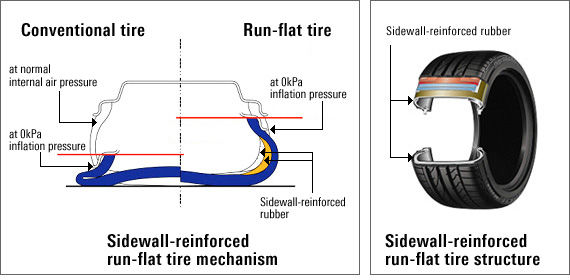In our first post of 2017, we’re looking at run flat tyres – what they are, their advantages and disadvantages and whether they’re right for you.
Run flat tyres are ones designed to be driven on, for a limited distance, even when they have lost all of their pressure. This means that in the event of a puncture, the driver can get to a garage or to a safe location to call for assistance.
To achieve this, most run flat tyres are made with reinforced sidewalls. Whereas regular tyres collapse as they lose pressure, making them unsafe to drive on, these tyres have inserts that continue to support the weight of the vehicle. For this reason, this type of tyre is also referred to as ‘self-supporting.’
An alternative run flat system was developed by Continental. These ‘self-sealing’ tyres work differently: an internal layer seals automatically around small punctures, preventing them from worsening. However, the technology hasn’t been widely adopted, and for the rest of our post, we will refer to the more common self-supporting type of run flat.
Run flat tyres been around for some time, with the first affordable makes appearing in the 1970s. By 1994, Chevrolet was offering run flats as an option on their new Corvette. Today, the main manufacturer supporting their use is the mighty BMW group, and they are also fitted to a number of Mercedes models.
Before we consider the advantages and disadvantages of run flat tyres, let’s first consider when they can be used safely.
Run flats aren’t designed for everyone
There are some situations where run flats are definitely not recommended.
Firstly, run flats are best used with cars that were originally sold fitted with them. Bear in mind that if a manufacturers designs a car to use run flats, the suspension and braking will be developed with that assumption in mind. Conversely, manufacturers who don’t fit run flatsfrom new will engineer their suspensions accordingly. Swapping to a different type of tyre to the one it was designed for may alter the vehicle’s handling, braking and ride.
Secondly, run flats require the car to be fitted with a tyre pressure monitoring system. Without this, the driver may be completely unaware that the tyre has lost pressure, because the car continues to handle normally. This is potentially dangerous, as run flat tyres are only designed to run for a few miles (typically 30 -50) before being replaced.This also means that run flats are not suitable for caravans and trailers, as these usually lack any tyre pressure monitoring.
Finally, mixing types of tyre on the same vehicle is not recommended, as run flats and regular tyres have different handling characteristics.
The pros and the cons
A tyre that runs even after a puncture sound ideal, but like most features on cars, there are pros and cons. Here are the positives:
- The huge advantage to using run flats is that they can get you out of a situation that might otherwise be unpleasant or downright dangerous. For example, with a conventional tyre, getting a puncture at 2am on a twisty country road might leave you struggling to find a place to pull over safely. You’re then stuck there until you’re able to change the tyre or a mobile tyre-fitting service arrives.
- Likewise, on conventional tyres, a blow out at speed will probably lead to your vehicle behaving unpredictably – with all the safety implications for you, your passengers and other road users. Used properly, run flat tyres are much less likely to suffer catastrophic failure.
- Using run flats also mean that you can ditch the spare tyre and auxillary – leaving the vehicle with more storage space and a lower kerb weight. With regard to the latter, however, you’re unlikely to notice much of a difference – especially as run flat tyres are heavier than conventional ones.
Despite these considerable advantages, run flats also have some potential drawbacks:
- Once damaged, it’s unlikely that a run flat can be repaired. If the tyre has been used in a deflated state, the side wall will have been put under pressure, reducing its integrity. This leaves it vulnerable to failure. By contrast, punctures in conventional tyres can be repaired under certain circumstances.
- Many drivers report that run flat tyres give a less comfortable ride. The stiffer material used in the sidewalls may result in more jarring over speedbumps, potholes and so on. How significant this is depends on who you listen to -the keen drivers at pistonheads share their views on ride quality and handling on this thread.
- Run flat tyres tend to be more expensive than conventional tyres, though buying from a dealer with competitive prices can help mitigate this.
Further advice on fitting run flats
Whether run flats are for you will depend on your driving habits and how important you find the reassurance that they can bring. For further expert guidance on whether they’re a good option for you, why not get in touch with our friendly team.

